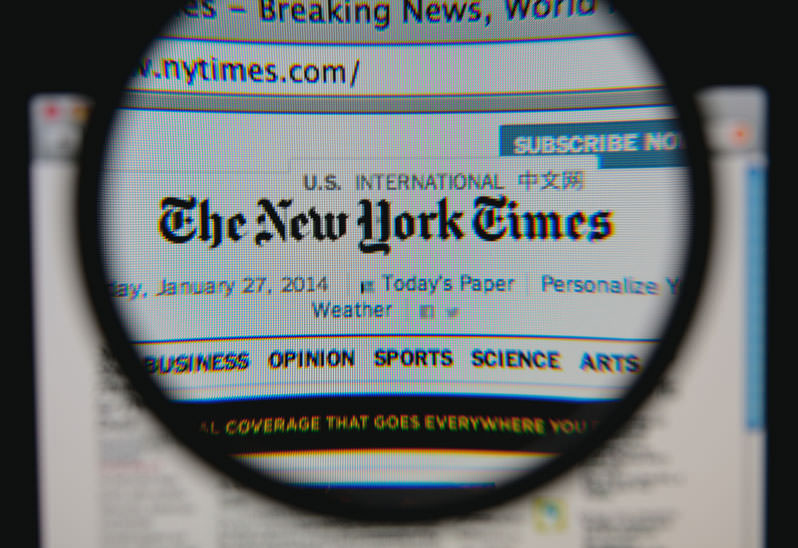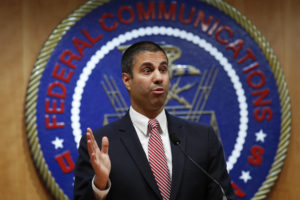The New York Times’ Desperate Dive to the Bottom
The motto of The New York Times has long been “All the News That’s Fit to Print.” After reading the Times report on how the paper might survive the digital era, I’m afraid it could be overtaken by a concept called “good enough.” Gil C / Shutterstock.com
Gil C / Shutterstock.com
The motto of The New York Times has long been “All the News That’s Fit to Print.” After reading the Times report on how the paper might survive the digital era, I’m afraid it could be overtaken by a concept called “good enough.”
“We must push back against our perfectionist impulses,” the report released last month said.
The report, prepared by an internal task force headed by Arthur Gregg Sulzberger, an heir to the paper and formerly assistant metro editor, is called Innovation. In 96 pages, it prescribes drastic surgery to push the paper away from its fixation with print. Technical savvy and quick adaptability would be the hallmark of a new Times journalist — that and an ability to find and connect with an audience in the manner of The Huffington Post and the hot site BuzzFeed.
“… The New York Times needs to accelerate its transition from a newspaper that also produces a rich and impressive digital report to a digital publication that also produces a rich and impressive newspaper,” the authors of Innovation said. It will be, they warned, a “painful transformation that will require us to rethink much of what we do each day.”
Innovation is a fascinating document. It reveals a newspaper staff at war with itself, techies versus print people. It’s easy to spot the eventual losers. They will be the print women and men taking time to nail down sources and study documents and data. They’re the types who check everything and then scurry to recheck when a copy editor asks a question that hadn’t occurred to anyone else. Out of here, old-timer, and take that copy editor with you.
The report reveals how desperate the newspaper is to survive, willing to try anything to prevent the Sulzberger family from losing it, going the way of other former family-owned newspapers such as The Washington Post, The Wall Street Journal and the Los Angeles Times.
I lived through such desperation at the L.A. Times. During the O.J. Simpson murder trial in the mid-1990s, I was writing a column, The Spin, on the court proceedings several days a week. O.J. was the hottest thing in America at the time and our nascent online operation asked me to conduct a chat room in the evening. I was reluctant. But I liked the online crew and figured a new experience would be good for me. So I reported to the online office, a dingy cramped space in a remote part of our building. The Internet was on the verge of taking over the media world, but the crummy quarters showed what the Times bosses thought of it. Any chance of innovative thinking was also frustrated by a bitter internal feud. A powerful faction of the Chandler family, heirs to the Times, was worried about circulation, advertising revenue and their own dividends. They wanted to sell the Times Mirror Co., which owned the Times and other papers.
Our chat room and other online features should have helped point the paper toward the digital era. The readers who logged into the chat room were devoted O.J. trial followers. Some were a little off-kilter. But most were well informed. A few knew more than I did, and I was at the Criminal Courts Building every day. I had to type fast to keep up with the questions. A skeptic at first, I saw that the chat room was a valuable way to connect with readers, unusual at a paper where complaining callers were often routed to the “nut phone,” usually manned by a copy messenger.
Online remained low on the agenda. I didn’t have much to do with it until the 2000 Democratic convention came to Los Angeles. By then, I was city editor. Turmoil had become a way of life at the paper. The Chandlers had sold out to the Tribune Co., publishers of the Chicago Tribune. A new crew, headed by editor John Carroll and managing editor Dean Baquet, was in charge and their main interest was in breaking up what they obviously considered an unsatisfactory print news operation and replacing it with a newspaper more to their tastes.
When the online crew came to me with a challenging proposition, I was open to it. They wanted to, in effect, blog the convention every day, frequently updating the daily demonstrations and other happenings outside the Staples Center. I thought it would be exciting, just like the deadline-every-minute Associated Press, where I used to work. I assigned two of my best — and fastest — writers, Ed Boyer and Eric Malnic, and they dived into the work with great enthusiasm. The paper should have promoted it. But online remained unimportant to our bosses, who remained focused on remaking the print newspaper. A few years later, retired from the paper and now an online journalist, I attended a conference on something called “Newspaper Next,” sponsored by the American Press Institute. I had begun work on a memoir about journalism and me — I still haven’t finished it — and thought the conference, held at the University of Southern California, would give me ideas. It was there that I was introduced to the two concepts that became the foundation of The New York Times Innovation report almost a decade later. They were “disruptive innovation” and “good enough.” Disruptive innovation came from professor Clay Christensen of Harvard Business School, author of the influential book “The Innovator’s Dilemma.”
Cameras in smartphones are a disruptive innovation. They disrupted the camera business by making separate point-and-shoot devices all but obsolete. The pictures, particularly at first, were far from perfect. But they were “good enough,” and the cameras were convenient and simple. Flaws could be corrected later. The Internet is another such innovation. To deal with it, the Innovation report adopts the philosophy of “good enough.”
Here’s how Innovation put it: “Unlike a printed newspaper (which is published to near perfection and launched once a day) a digital experiment should be released quickly and refined through a cycle of continuous improvement, measuring performance, shuttering losers and building on winners. …”
In another and highly significant portion of its report, the Innovation team urged a much closer collaboration between the news gatherers and editors and the business side. This is also something with which I had personal experience. Our Los Angeles Times advertising department had worked out a deal with the Staples arena to share revenue from an issue of our magazine hailing the opening of the place. The staff, firmly wedded to the separation of the business and news departments — calling it a wall and comparing it to the separation of church and state — rebelled. I was part of the rebellion, standing by the city desk and reading a letter to the entire staff from our respected former publisher, Otis Chandler, denouncing the deal.
Today, such collaboration is an accepted part of the media business and we rebels are relics of a lost war. The Innovation report said the first step toward equipping The New York Times for the digital age “should be a deliberate push to abandon our current metaphors of choice — ‘the wall’ and ‘church and state,’ which project an enduring need for division.’ ” Scorning the old ways, the authors of Innovation accuse the newsroom of being “precious about its work and sanctimonious about its values.” Innovation would link business and news through “product managers,” whose job would be to come up with ideas for new products. One proposal was that “a product manager work with a columnist for two months.”
That illustrates what’s wrong with the Times’ thinking. Strong columns come from the mind and convictions of a good columnist, not from data derived from focus groups and reader surveys, filtered through a product manager. So does much else valuable in journalism.
Innovation has none of the heart and soul and little of the dedication to news values that prompted Adolph Ochs, then The New York Times proprietor, to adopt the slogan “All the News That’s Fit to Print” in 1896. Rather, the Innovation report reads like a frantic new marketing strategy for a failing retail chain.
Your support matters…Independent journalism is under threat and overshadowed by heavily funded mainstream media.
You can help level the playing field. Become a member.
Your tax-deductible contribution keeps us digging beneath the headlines to give you thought-provoking, investigative reporting and analysis that unearths what's really happening- without compromise.
Give today to support our courageous, independent journalists.






You need to be a supporter to comment.
There are currently no responses to this article.
Be the first to respond.